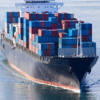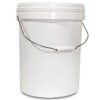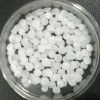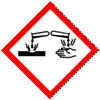| Aadhunik Industries is manufacturers of Potassium monopersulfate or Potassium Hydroxide Pellets, Pharmaceutical Excipients in India. We offer Halal and Kosher Potassium Monopersulfate or Potassium Monopersulfate or Potassium peroxymonosulfate made in an ISO9001, ISO22000 (FSSC22000). We observe good manufacturing practice and good laboratory practice. |
| The units have one or more of the certifications like FDA GMP, ISO 9001, ISO 22000, HACCP, REACH, Kosher & Halal |




Caustic Potash or Potassium Hydroxide Pellets SDS of Suppliers Manufacturers
Caustic Potash or Potassium Hydroxide Pellets Specifications Sheet of Manufacturers.
CAS Number: 1310-58-3

Potassium Hydroxide Pellets BP USP NF FCC Food Analytical Reagent
Caustic Potash Potassium Hydroxide SDS, Safety Data Sheet
MSDS, Material Safety Data Sheet
Section 1: Product Identification
Product Name & Other Names : Caustic potash or Potassium hydroxide solid, flakes, pellets powder.
CAS No.: 1310-58-3
EINECS EC Number: 215-181-3
Section 2: Hazard Identification
GHS, Globally Harmonized System Classification in accordance with 29 CFR 1910
Classification according to Regulation (EC) No 1272/2008
Corrosive to Metals Category 1, H290
Acute toxicity, oral Category 4, H302
Skin corrosion/irritation Category 1A, B, C, H314
Hazardous to the aquatic environment, acute hazard Category 3, H402
Labeling according to Regulation (EC) No 1272/2008
GHS Label Elements  Corrosive |
Signal Words: Danger
Hazard statements:
H290: May be corrosive to metals
H302: Harmful if swallowed
H314: Causes severe skin burns and eye damage
H402: Harmful to aquatic life.
Precautionary statements:
P234: Keep only in original container.
P260: Do not breathe dust/fume/gas/mist/vapors/spray.
P264: Wash … thoroughly after handling.
P270: Do not eat, drink or smoke when using this product.
P273: Avoid release to the environment.
P280: Wear protective gloves/protective clothing/eye protection/face protection.
P362: Take off contaminated clothing and wash before reuse.
P301+330+331: IF SWALLOWED: Rinse mouth. Do NOT induce vomiting.
P301+312: IF SWALLOWED: Call a POISON CENTER or doctor/physician if you feel unwell.
P303+361+353: IF ON SKIN (or hair): Remove/Take off immediately all contaminated clothing. Rinse skin with water/shower.
P305+351+338: IF IN EYES: Rinse cautiously with water for several minutes. Remove contact lenses if present and easy to do – continue rinsing.
P404: Store in a closed container.
P405: Store locked up.
P501: Dispose of contents/container to authorized agents only.
Section 3: Composition / Information on Ingredients
Product Name & Other Names: Caustic potash or Potassium hydroxide solid, flakes, pellets powder.
CAS No.: 1310-58-3
EINECS EC Number: 215-181-3
Percent: 85 - 100%
Section 4: First Aid Measures
Always seek medical attention after first aid measures are provided.
Eye Contact: Check for and remove any contact lenses. In case of contact, immediately flush eye with plenty of water for at least 15 minutes. Cold water may be used. Get medical attention immediately.
Skin Contact: Immediately flush skin with plenty of water for at least 15 minutes while removing contaminated clothing and shoes. Call a physician, immediately. Wash clothing before reuse.
Ingestion: If swallowed, do not induce vomiting unless directed to do so by medical personnel. Never give anything by mouth to and unconscious person. Loosen tight clothing such as a collar, tie, belt, or waistband. Get medical attention immediately.
Section 5: Fire Fighting Measures
Flash Point: NA
Fire Extinguishing Media: Adapt extinguishing media to the environment. Use water spray, alcohol-resistant foam, dry chemical or carbon dioxide.
Extinguishing Media Not recommended: None specified.
Unusual Fire and Explosion Hazards: Flammable hydrogen gas may be produced on prolong contact with metals such as aluminum, tin lead and zinc.
Hazardous combustion products: Oxides of Potassium.
Special Information: In the event of a fire, wear full protective clothing and NIOSH-approved self-contained breathing apparatus with full face piece operated in the pressure demand or other positive pressure mode. At high temperatures under fire conditions, it may produce toxic or irritating fumes. Fire-extinguishing work is done from the windward and the suitable fire-extinguishing method according to the surrounding situation is used.
Section 6: Accidental Release Measures
Personal precautions, protective equipment, and emergency procedures: Wear suitable protective equipment. Ventilate area of leak or spill. Avoid breathing dust/fumes/gas/mist/vapors/spray. Use individual protective equipment (waterproof boots, suitable protective clothing, safety glasses, etc.). Restrict unprotected personnel from the area. Do not approach facing the wind.
Environmental precautions: Do not let the product enter drains, soil, or water sources.
Methods and materials used for containment cleanup procedures and Storage: Small quantities of liquid spill may be neutralized with acid solution. Wash away neutralized product with plentiful water. Contain spilled material. Take up liquid spill into absorbent material, e.g.: dry sand/earth or powdered limestone. Cover with an inert, non-combustible absorbent material, (e.g., sand, earth, diatomaceous earth, vermiculite). Vacuum or sweep-up and remove to an approved disposal container.
Section 7: Handling and Storage
Precautions for safe handling: Ensure proper ventilation. Do not drink, eat, or smoke while handling. Avoid contact with skin, eyes, and clothing. Minimize dust generation. Avoid breathing dust/fumes/gas/mist/vapors/spray. Avoid contact with eyes, skin, and clothing. Keep container tightly closed. Avoid ingestion and inhalation. Use individual protective equipment (waterproof boots, suitable protective clothing, safety glasses, etc.).
Conditions for safe storage, including any incompatibilities: Store in cool, dry, and ventilated area away from heat sources and protected from sunlight in tightly closed original container. Keep air contact to a minimum. Store protected from heat, sparks and ignition sources and incompatible materials. Avoid inhalation of dust/mist/vapor. Do not store with incompatible materials like strong oxidizing agents and water, acids, chlorinated hydrocarbons, metals, and organic materials. Always add the material to water while stirring and never the reverse.
Section 8: Exposure Controls / Personal Protection
Components with workplace control parameters
Derived No Effect Level (DNEL):
Application Area: Workers & Consumers
Exposure routes: Inhalation
Health effect Value, Long-term local effects: 1 mg/m3
USA ACGIH: 2 mg/m³ ACGIH Ceiling (mg/m³)
USA OSHA: 2 mg/m³
Britain EH40: 2 mg/m³ OEL STEL (mg/m³)
Engineering Controls Ventilation required: The material should be handled or transferred in an approved fume hood or with adequate ventilation.
Ventilation System: A system of local and/or general exhaust is recommended to keep employee exposures as low as possible. Local exhaust ventilation is generally preferred because it can control the emissions of the contaminant at its source.
Personal Respirators (NIOSH Approved): For conditions of use where exposure to dust or mist is apparent and engineering controls are not feasible, a particulate respirator may be worn. For emergencies or instances where the exposure levels are not known, use a full-face positive-pressure, air-supplied respirator.
Skin Protection: Wear protective gloves and clean body-covering clothing.
Eye Protection: Use chemical safety goggles and/or full-face shield where dusting or splashing of solutions is possible. Maintain eye wash fountain and quick-drench facilities in work area.
Other Control Measures: Maintain good housekeeping in work area. Handle in accordance with good industrial hygiene and safety practice.
Section 9 Physical and Chemical Properties
Appearance: White deliquescent solid
Odor: Odorless.
Odor threshold: Not available.
pH: 13.5 (0.1 molar solution)
Relative density: around 2.04
Boiling Point: 1320C.
Melting Point: 360C.
Flash point: Not available.
Auto-ignition temperature: Not available.
Decomposition temperature: Not available.
Upper/lower flammability or explosive limits: Not available.
Vapor pressure: Not available.
Vapor density: Not available.
Evaporation rate: Not available.
Flammability (solid, gas): Not available.
Partition coefficient: n-octanol/water: Not available.
Solubility: 52.8% in water @ 20C (68F)
Viscosity: Not available.
Section 10: Stability and Reactivity
Stability: Stable under ordinary conditions of use and storage. Very hygroscopic. Absorbs atmospheric CO2.
Reactivity: Exothermic reaction with water. Heat of solution is remarkably high and with limited amounts of water, violent boiling may occur. Violent exothermic reaction with strong acids. Reacts with some metals to release hydrogen.
Conditions to Avoid: Contact with moisture may generate sufficient heat to ignite surrounding combustible material.
Materials to Avoid (Incompatibility): Water, acids, chlorinated hydrocarbons, oxidizing agents, metals and organic materials, Nitro compounds, Organic materials, Magnesium, Copper, Water, reacts violently with: Metals, Light metals, Contact with aluminum, tin and zinc liberates hydrogen gas. Contact with nitromethane and other similar nitro compounds causes formation of shock-sensitive salts., vigorous reaction with: Alkali metals, Halogens, Azides, Anhydrides
Hazardous Decomposition Products: None indicated.
Hazardous Polymerization: None reported.
Section 11: Toxicological Information
The material is corrosive to all tissues. It is a severe eye, skin, and respiratory tract irritant, and can burn any tissue with which it comes in contact. Contact with eye may cause redness, intense pain, and tearing. In severe cases, conjunctival edema and destruction of cornea may occur, which may result in permanent damage to the eye. It is a severe skin irritant and contact with the skin can cause effects ranging from irritation to burns with deep and painful lesions. Burns may not be immediately painful. The onset of pain after contact may take minutes to hours.
Extremely hazardous in case of eye contact (corrosive). Causes severe eye burns. Extremely hazardous in case of skin contact (corrosive). Skin contact produces severe burns. Hazardous in case of skin contact (permeator). Extremely hazardous in case of inhalation (lung corrosive). Extremely hazardous in case of ingestion. May be fatal if swallowed. This product does not contain any compounds listed by NTP or IARC or regulated by OSHA as a carcinogen.
Results of component toxicity test performed:
LD50 Oral - Rat - 333 mg/kg
LD50 Skin-Rabbit - 1260 mg/kg.
Section 12: Ecological Information
Toxicity to fish:
Toxicity to fish: LC50 Gambusia affinis (Mosquito fish): 80 mg/l; 96 h (IUCLID)
Toxicity to bacteria: EC50 Photobacterium phosphoreum; 15 min
Results of PBT and vPvB assessment: This substance/mixture contains no components considered to be either persistent, bioaccumulative and toxic (PBT), or very persistent and very bioaccumulative (vPvB) at levels of 0.1% or higher. Avoid discharge into the environment.
Section 13 Disposal Considerations
Offer surplus and non-recyclable solutions to a licensed disposal company. Dissolve or mix the material with a combustible solvent and burn in a chemical incinerator equipped with an afterburner and scrubber. Contaminated packaging must be disposed of as unused product.
Section 14: Transportation Information
DOT USA, TDG Canada & ADR/RID Europe:
Proper shipping name: Potassium Hydroxide, solid
Hazard Class: 8, Packaging group: II
UN Number: UN1813
IMDG/IMO:
Proper shipping name: Potassium Hydroxide, solid
Hazard Class: 8, Packing group: II
UN Number: UN1813
IATA/ICAO:
Proper shipping name: Potassium Hydroxide, solid
Hazard Class: 8, Packing group: II
UN Number: UN1813
Section 15: Regulatory Information
USA:
California Prop 65 Components: This product does not contain any chemicals known to the State of California to cause cancer, birth, or any other reproductive defects.
Section 16: Other Information
DISCLAIMER: The information and recommendations set forth herein are presented in good faith and believed correct as of the date hereof. It is compiled from various sources, and it is not necessarily all inclusive nor fully adequate in every circumstance. In addition, these suggestions should not be confused with nor followed in violation of applicable laws, regulations, rules, or insurance requirements applicable. This SDS MSDS sheet is intended only as a guide to the appropriate precautionary handling of the material by a professionally trained person using this product. Individuals receiving the information must exercise their independent judgment in determining its appropriateness for a particular purpose. This shall not constitute a guarantee for any specific product features and shall not establish a legally valid contractual relationship. In no case shall our company be liable to loss or damages by the product user.Caustic Potash or Potassium Hydroxide Pellets Manufacturers:
Aadhunik Industries
S-8, SARIFA MANSION, 2ND PRINCIPAL S H MARG, MUMBAI 400009, INDIA
TEL: (OFFICE) 91-22-23770100, 23726950, 23774610, 23723564. FAX: 91-22-23728264
e-mail: anmolc@mtnl.net.in
Exports to USA, Canada, UAE, Dubai, South Africa, Tanzania, Kenya, Nigeria, Egypt, Uganda, Turkey, Mexico, Brazil, Chile, Argentina, Europe Netherlands, Italy, Spain, Germany, Portugal, France, Malaysia, Indonesia, Thailand, Korea, Japan,etc.
It is nice to be important
But it is more important to be nice.